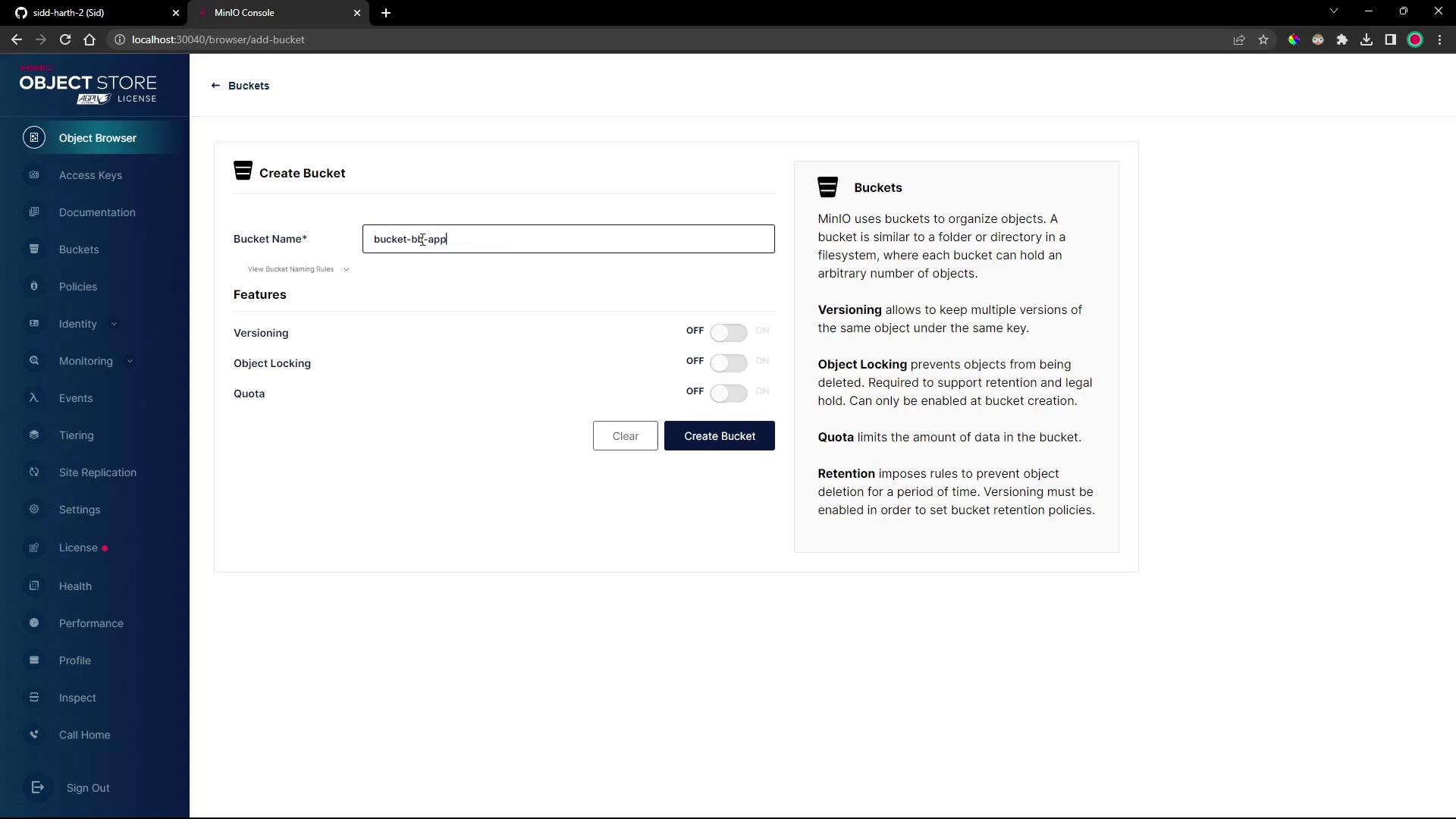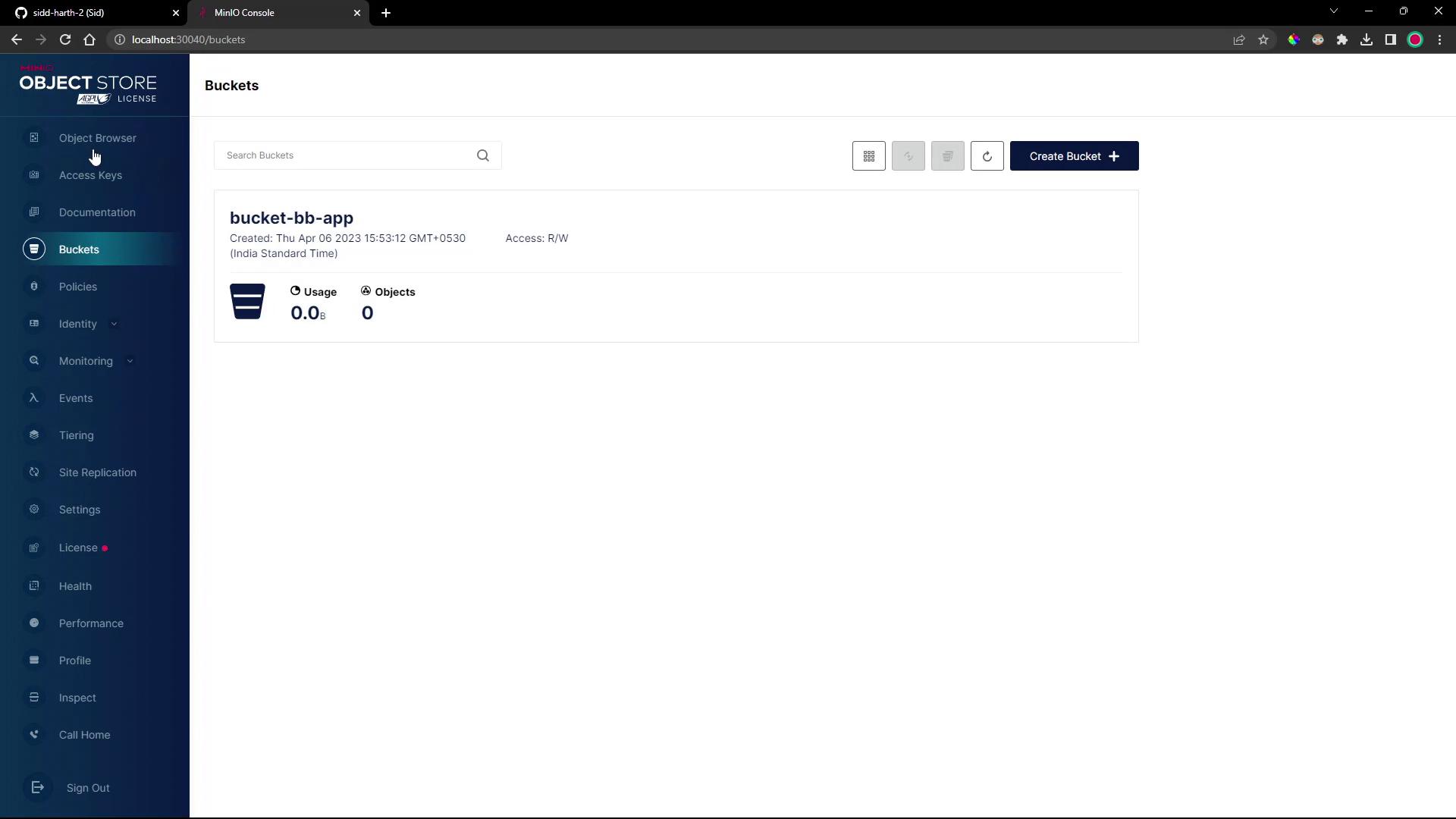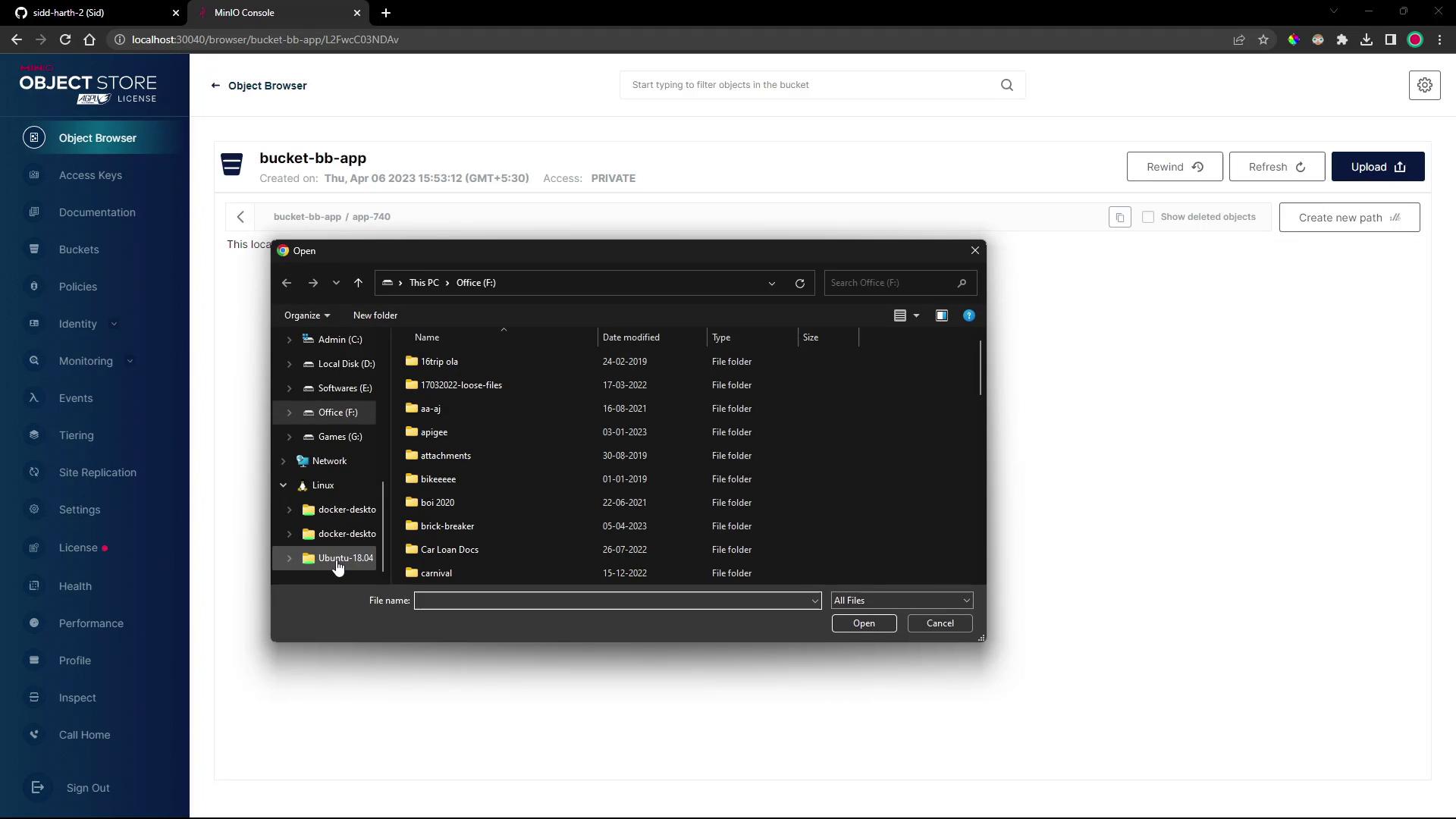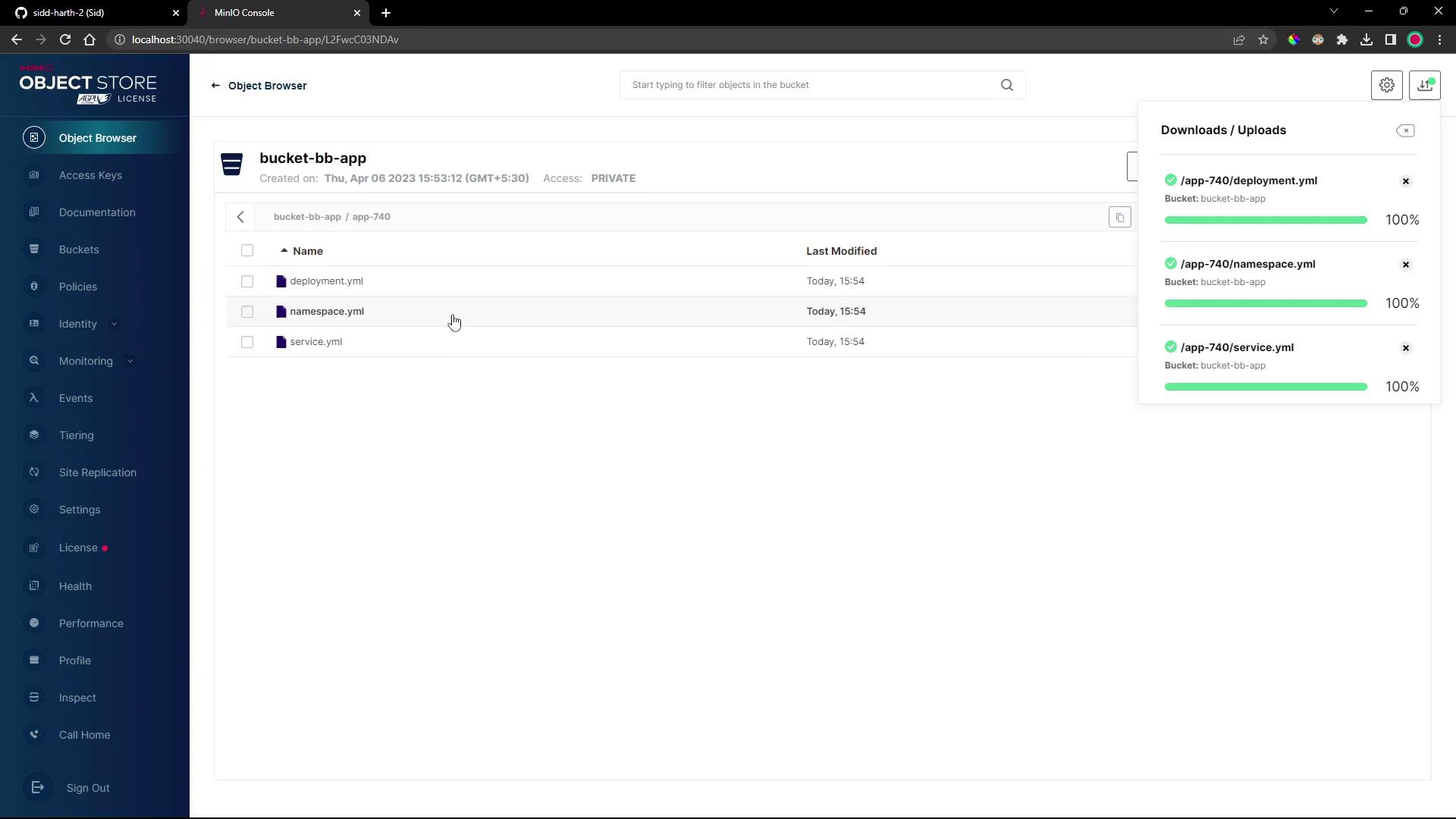GitOps with FluxCD
Source and Kustomize Controller
DEMO Source Controller S3 Bucket
Leverage Flux’s Source Controller to fetch Kubernetes manifests from an S3-compatible store (MinIO) and deploy them via GitOps. In this walkthrough, you will:
- Set up a dedicated Git branch with demo manifests
- Deploy MinIO locally as an S3 replacement
- Create a bucket, upload manifests, and configure Flux sources
- Apply and verify your application in the cluster
1. Prepare the Demo Branch
Open your terminal in Visual Studio Code and switch to the 4-demo branch of the bb-app-source repo:
root ~/bb-app-source 3-demo
➤ git checkout 4-demo
Branch '4-demo' set up to track remote branch '4-demo' from 'origin'.
Switched to a new branch '4-demo'
root ~/bb-app-source 4-demo
➤
In this branch, the 4-demo directory contains three manifests:
namespace.ymldeployment.yml(version 7.4.0)service.yml
Example excerpt from deployment.yml:
env: dev
version: 7.4.0
spec:
containers:
- name: app
image: siddharth67/block-buster-dev:7.4.0
imagePullPolicy: Always
resources:
requests:
memory: "10Mi"
cpu: "10m"
limits:
memory: "64Mi"
cpu: "20m"
2. Deploy MinIO as an S3-Compatible Store
Apply the MinIO manifest to create a namespace, pod, and service:
root ~/bb-app-source 4-demo
▶ kubectl apply -f minio/minio-s3.yml
namespace/minio-dev created
pod/minio created
service/minio created
Verify the MinIO deployment:
kubectl -n minio-dev get all
| NAME | READY | STATUS | AGE |
|---|---|---|---|
| pod/minio | 1/1 | Running | 13s |
| NAME | TYPE | PORT(S) | AGE |
|---|---|---|---|
| service/minio | NodePort | 9000:30040/TCP, 9000:30041/TCP | 13s |
| Port | Purpose |
|---|---|
| 30040 | MinIO Web Console (HTTP) |
| 30041 | MinIO S3-compatible API |
Note
By default, MinIO uses minio-admin:minio-admin for S3 authentication. Keep this credential secure in production.
3. Create a Bucket and Upload Manifests
Open the MinIO console at http://localhost:30040
Authenticate with:
- Username:
minio-admin - Password:
minio-admin
- Username:
Create a bucket named bucket-bb-app using all defaults.

- In the Object Browser, select bucket-bb-app.

- Create a folder called app740 and upload
namespace.yml,deployment.yml, andservice.ymlfrom your localbb-app-source/4-demofolder.

- Confirm all three manifests appear under
bucket-bb-app/app740/.

4. Create a Flux Bucket Source
Instead of Git, Flux will track this S3 bucket via the Bucket API. Generate the source manifest and export it to your cluster repo:
flux create source bucket 4-demo-source-minio-s3-bucket-bb-app \
--bucket-name bucket-bb-app \
--endpoint minio.minio-dev.svc.cluster.local:9000 \
--provider generic \
--secret-ref minio-crds \
--insecure \
--interval 1m \
--export > ../block-buster/flux-clusters/dev-cluster/4-demo-source-minio-s3-bucket-bb-app.yml
Generated Bucket resource:
apiVersion: source.toolkit.fluxcd.io/v1beta2
kind: Bucket
metadata:
name: 4-demo-source-minio-s3-bucket-bb-app
namespace: flux-system
spec:
bucketName: bucket-bb-app
endpoint: minio.minio-dev.svc.cluster.local:9000
provider: generic
insecure: true
secretRef:
name: minio-crds
interval: 1m0s
5. Create a Flux Kustomization
Point your Kustomization at the app-740 folder in the bucket:
flux create kustomization 4-demo-kustomize-minio-s3-bucket-bb-app \
--source Bucket/4-demo-source-minio-s3-bucket-bb-app \
--path ./app-740 \
--prune=true \
--target-namespace 4-demo \
--interval 1m \
--export > ../block-buster/flux-clusters/dev-cluster/4-demo-kustomization-minio-s3-bucket-bb-app.yml
Generated Kustomization:
apiVersion: kustomize.toolkit.fluxcd.io/v1beta2
kind: Kustomization
metadata:
name: 4-demo-kustomize-minio-s3-bucket-bb-app
namespace: flux-system
spec:
sourceRef:
kind: Bucket
name: 4-demo-source-minio-s3-bucket-bb-app
path: ./app-740
prune: true
targetNamespace: 4-demo
interval: 1m0s
6. Create the MinIO Credentials Secret
Flux requires a Kubernetes secret for S3 access. First, confirm Flux sees no secret:
flux get sources bucket
Create minio-crds in the flux-system namespace:
kubectl -n flux-system create secret generic minio-crds \
--from-literal=accesskey=minioadmin \
--from-literal=secretkey=minioadmin
Reconcile and verify:
flux reconcile source bucket 4-demo-source-minio-s3-bucket-bb-app
flux get sources bucket
# NAME READY MESSAGE
# 4-demo-source-minio-s3-bucket-bb-app True
Warning
Storing credentials in plain text can be insecure. Consider using Sealed Secrets or a vault in production.
7. Confirm Deployment in 4-demo
Flux will now apply the manifests under the 4-demo namespace:
kubectl -n 4-demo get all
Example output:
NAME READY STATUS RESTARTS AGE
pod/block-buster-7f8c7c588f-xqf8k 1/1 Running 0 40s
NAME TYPE CLUSTER-IP EXTERNAL-IP PORT(S) AGE
service/block-buster-service NodePort 10.98.175.100 <none> 80:30004/TCP 40s
NAME READY UP-TO-DATE AVAILABLE AGE
deployment.apps/block-buster 1/1 1 1 40s
Access the application at http://localhost:30004. In version 7.4.0, a new score counter updates whenever a brick is hit.
Resources & References
| Resource | Use Case | Documentation |
|---|---|---|
| Flux Bucket | Track S3 or HTTP directories as sources | https://fluxcd.io/docs/components/source/bucket/ |
| Flux Kustomize | Declarative application deployment | https://fluxcd.io/docs/components/kustomize/ |
| MinIO | S3-compatible object store | https://min.io/ |
Watch Video
Watch video content
Practice Lab
Practice lab